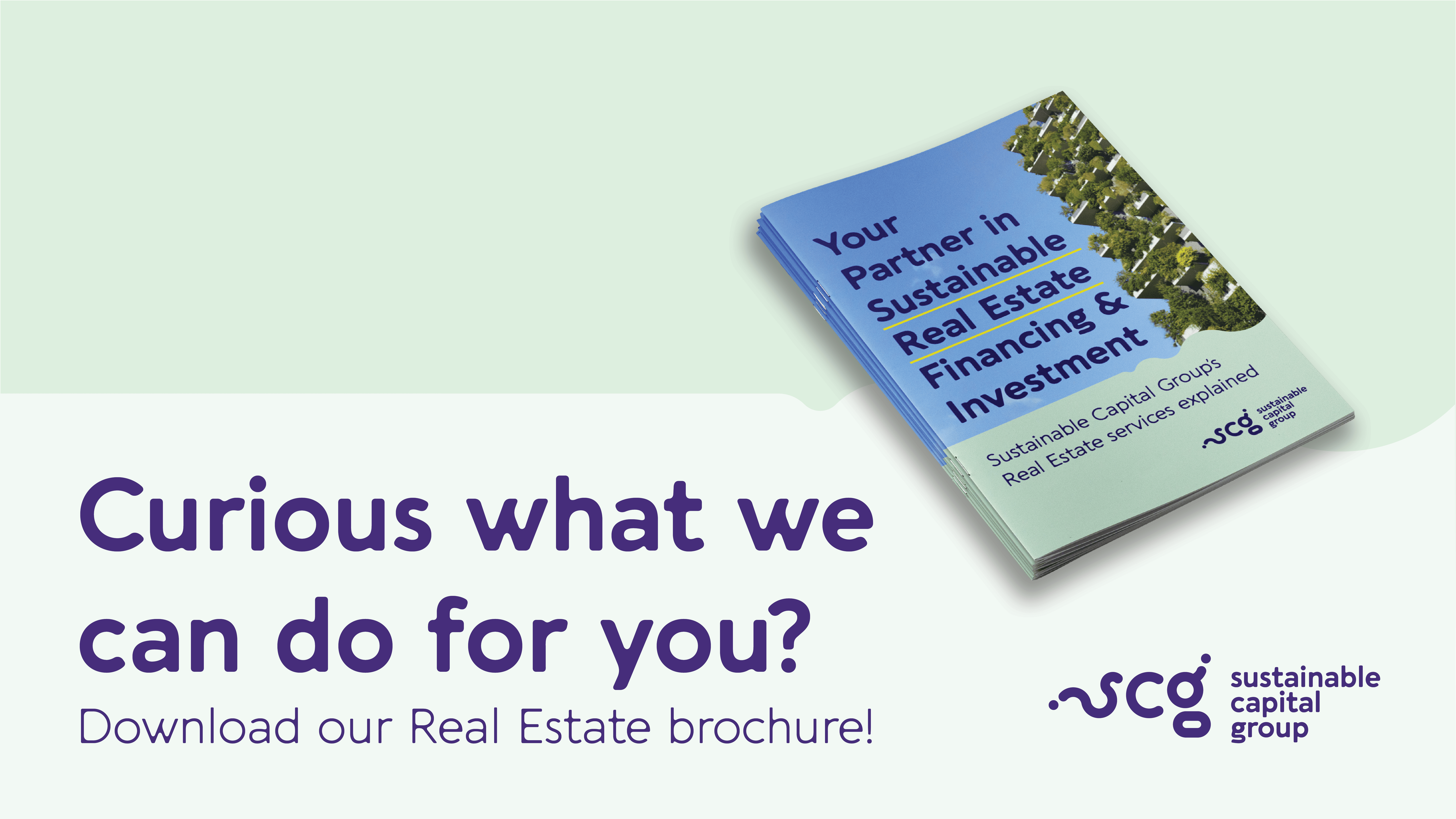Refinancing for Sustainable Development: Leveraging Green Bonds for Real Estate Projects
Sustainability has become a key consideration in today’s real estate financing. Why? As environmental concerns and regulatory pressures increase, such as carbon reduction mandates and energy efficiency requirements, the demand for sustainable development practices in real estate surges.
Among the innovative financing tools that have emerged, green bonds stand out as a powerful mechanism to promote sustainability, particularly for real estate assets.
These bonds attract investors who are increasingly focused on environmental, social, and governance (ESG) criteria, thereby channelling capital into sustainable real estate projects and fostering long-term environmental stewardship.
This blog explores how green bonds can be an effective (re)financing tool for real estate projects, emphasising their critical role in advancing sustainable development.
What is a Green Bond?
Green bonds are a type of loan specifically appropriate for projects with a positive impact on the environment. These bonds adhere to specific guidelines to ensure that the proceeds are utilised for green initiatives.
Over the past decade, the green bond market has grown exponentially, reflecting a broader commitment to environmental sustainability across the financial sector. According to Bloomberg, by the end of 2023, $649.8 billion worth of green bonds were issued globally, marking an 8.2% year-on-year increase from 2022.
Eligibility Criteria for Green Bonds
Criteria
Real estate projects must meet specific environmental criteria to qualify for green bond funding. This may include high energy efficiency, renewable energy installations, sustainable water management systems, and other initiatives that reduce carbon footprints and mitigate the building’s environmental impact.
To qualify as a green bond, the issuance must meet several criteria, which can vary slightly depending on the standards and frameworks being used, but generally include the following key aspects:
- Use of proceeds: The capital raised through green bonds must be used exclusively for projects that have clear environmental benefits.
- Project evaluation and selection: The issuer must establish a clear process for project evaluation and selection, ensuring that the projects meet the environmental objectives.
- Management of proceeds: The proceeds from the green bond issuance must be managed separately from other funds and should be tracked to ensure they are used exclusively for eligible projects.
- Reporting: Issuers are expected to provide regular reports, at least annually, detailing the allocation of proceeds and the environmental impact of the funded projects.
- Compliance with legal and regulatory frameworks: Issuers must comply with any national or international laws and regulations governing green bonds, which can include disclosure requirements, reporting standards, and environmental regulations.
Frameworks
Frameworks such as the Green Bond Principles (GBP), established by the International Capital Market Association (ICMA), provide guidelines for the issuance of green bonds. The GBP outlines criteria for eligible projects, the process for project evaluation and selection, as well as the management of proceeds and respective reporting requirements. These frameworks differ from other bond frameworks by focusing exclusively on environmental benefits, ensuring high standards of environmental integrity.
Other frameworks, like the Climate Bonds Standard (CBS) by the Climate Bonds Initiative, offer additional certification, which can provide more stringent requirements and higher credibility. The CBS sets rigorous, science-based, sector-specific benchmarks that projects must meet to qualify, ensuring alignment with global climate goals. Additionally, the CBS is strict in excluding projects or activities that do not directly contribute to climate change mitigation or adaptation, ensuring that only the most impactful projects are funded.

Impact Measurement
Measuring the environmental and social impact of projects financed through green bonds involves specific KPIs. These may include energy savings, reductions in greenhouse gas emissions, improvements in water efficiency, and other metrics that reflect the sustainability performance of the projects.
To learn more, check out our blog on the criteria for creating effective sustainability KPIs.
Specifically for Real Estate projects, the BREEAM (Building Research Establishment Environmental Assessment Method) is a leading sustainability assessment method for master planning projects, infrastructure, and buildings. It awards ratings based on a building’s environmental performance, including classifications Pass, Good, Very Good, Excellent, and Outstanding. Green buildings funded by these bonds achieve high BREEAM ratings, all above Very Good.
Issuance and Compliance
Issuing green bonds involves a structured process to ensure funds are allocated to projects with genuine environmental benefits.
Identify Eligible Green Projects
First, issuers identify eligible projects such as green-certified buildings and sustainable urban developments, ensuring they meet criteria set by frameworks like the Green Bond Principles (GBP) or Climate Bonds Standard (CBS). Detailed feasibility studies and impact assessments evaluate their environmental benefits, financial viability, and associated risks.
Establish a Green Bond Framework
Next, a green bond framework is established, outlining the environmental goals, project selection criteria, evaluation processes, and management of proceeds, with transparency and governance mechanisms to ensure accountability.
Third-Party Verification and Assurance
Third-party verification is conducted by independent verifiers like Sustainalytics to assess the framework’s compliance with established standards, providing an assurance report to build investor confidence.
Marketing and Issuing Green Bonds
The bonds are then marketed to a broad range of investors interested in sustainable investments, priced based on market conditions and demand, and then issued.
Monitoring, Reporting, and Accountability
Finally, robust monitoring systems must be in place to track fund allocation and project implementation. Issuers provide regular updates and reports, at least annually, on the use of proceeds and the environmental impact of financed projects, often with third-party assurance to enhance credibility. Transparent and regular reporting to stakeholders is crucial for maintaining trust and accountability.
By following these steps, issuers can align their bonds with high environmental standards, attract environmentally conscious investors, and contribute to sustainable development goals.
Benefits of Green Bonds
Lower Interest Rates
Green bonds offer several financial benefits, including potentially lower interest rates due to the growing demand from environmentally conscious investors. A study by Amundi Research Center found that green bonds, across a variety of eligible projects, can achieve a pricing advantage of 4.7 basis points compared to conventional bonds due to this demand. This demand not only provides better pricing but also access to a broader investor base seeking sustainable investment opportunities, enhancing liquidity and marketability.
Boosting Reputation and Brand Value
Issuing green bonds can significantly enhance an issuer’s reputation for sustainability. It demonstrates a commitment to environmental stewardship and can attract investors who prioritise corporate social responsibility and sustainable investments.Furthermore, green bonds can enhance brand image, differentiate issuers in a competitive market, and align with stringent regulatory standards, thereby increasing trust and credibility among stakeholders.
Ready for the future
Green bonds can increase the long-term value and resilience of real estate projects. By financing sustainable initiatives, these projects are better positioned to adapt to future regulatory changes and environmental challenges. This proactive approach can result in higher property values and reduced operating costs over time.
Challenges
Higher Upfront Costs and Complex Processes
Issuing green bonds often incurs higher upfront costs due to the need for extensive verification, compliance, and reporting processes, as well as the added complexity compared to traditional bonds. These expenses may include fees for third-party verifiers, legal and advisory services, and the creation of detailed reporting frameworks.
More administrative work
The requirement to report on impact data and the specific use of proceeds imposes an additional administrative burden on green bond issuers, going beyond the typical financial reporting obligations of conventional bonds.
Regulatory Scrutiny and Greenwashing Risks
Moreover, increasing regulatory and market scrutiny aimed at preventing “greenwashing” requires issuers to rigorously substantiate their environmental claims and ensure alignment with well-established standards.
More generally, the Green Bond market faces the challenge of standardising the green bond criteria globally, addressing the higher initial costs for issuers, and managing the risk of “greenwashing” where bonds are labelled green without meeting rigorous environmental standards.
Real-World Examples
CBRE Investment Management has successfully raised €750 million through a Green Eurobond, marking their first issuance of such a bond since 2021. The bond has a 10-year term with an interest rate of 4.75% and is rated BBB+ by S&P, indicating a good quality investment. The issuance was highly sought after, with orders reaching €2.4 billion—three times the available amount. The bonds were primarily purchased by top-tier European investors, including asset managers, banks, pension funds, and insurance companies. The proceeds from this bond will be used exclusively for environmentally friendly projects, reflecting CBRE’s strong commitment to sustainability. The Green Finance Framework for this bond has been reviewed and approved by Sustainalytics, ensuring the projects funded are genuinely green and sustainable.
Vesteda’s €500 Million Green Bond Issuance
Similarly, Vesteda has successfully issued its third green bond this year, raising 500 million euros with an 8-year term and a 4% coupon. ING served as the sole Green Structuring Advisor, while ABN AMRO, Rabobank, and SMBC acted as Joint Bookrunners. The bond, which will be listed on Euronext Amsterdam, received an A- rating from S&P, consistent with Vesteda’s external credit rating.
The proceeds from Vesteda’s green bond will be allocated to homes with a minimum EPC label A, homes that have improved primary energy demand by at least 30% (to a minimum EPC label of C), and new build homes with energy performance at least 10% better than the threshold for Nearly Zero-Energy Buildings (NZEB). Vesteda is committed to reporting on the allocation of the proceeds, the estimated energy savings, and the greenhouse gas emission avoidance associated with this green bond.
Both examples underscore the growing interest in and commitment to green bonds as a tool for financing sustainable projects, with leading investors recognizing the value of supporting environmentally responsible initiatives.
For more examples, explore our case studies to see how Sustainable Capital Group secures financing for sustainable real estate projects.
Future Trends and Conclusion
The green bond market is poised for continued growth. According to S&P, $0.95 trillion to $1.05 trillion of green bonds is forecasted to be issued globally by the end of 2024, driven by increasing regulatory support, investor demand, and corporate sustainability commitments. Innovations in sustainable finance, such as the development of social and sustainability-linked bonds, are also likely to influence future trends in the market. These emerging instruments provide additional avenues for financing projects that deliver positive social and environmental outcomes.
Green bonds represent a powerful refinancing tool for real estate projects, offering financial advantages, enhancing reputation, and promoting long-term sustainability. By adhering to established standards and demonstrating a commitment to environmental stewardship, issuers can leverage green bonds to achieve their investment and sustainability goals.
Real estate developers and investors are encouraged to consider green bonds as a viable refinancing tool to support sustainable development. By integrating green bonds into their financing strategies, they can contribute to a more sustainable future while achieving financial success.
Any Questions?
At Sustainable Capital Group, we understand Sustainable Finance like no other. For tailored guidance, simply fill out our contact form, and we’ll be in touch with you shortly.





